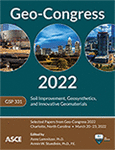Stabilization of Mine Tailings Using Microbiological Induced Carbonate Precipitation for Dust Mitigation: Treatment Optimization and Durability Assessment
Publication: Geo-Congress 2022
ABSTRACT
Wind erosion (dust) is a severe problem for mine tailings industry, as it poses environmental and safety concerns to public. In this study, microbiologically induced carbonate precipitation (MICP) based on urea hydrolysis was used to stabilize the surface of different tailings materials. An experimental study was performed on soil-filled pans that were prepared using loosely packed tailings material and treated using percolation of reactive solutions. Penetration testing and calcium carbonate content analysis were used to optimize the treatment strategy and assess the strength and durability of the cemented crusts. The MICP treated pans showed an increase in strength and durability with increasing concentration of the cementation solution and number of treatments.
Get full access to this article
View all available purchase options and get full access to this chapter.
REFERENCES
ASTM D2487-17. (2020). Standard Practice for Classification of Soils for Engineering Purposes (Unified Soil Classification System).
ASTM D5084-16. (2016). Standard Test Methods for Measurement of Hydraulic Conductivity of Saturated Porous Materials Using a Flexible Wall Permeameter.
Bang, S., Min, S. H., and Bang, S. S. (2011) Application of Microbiologically Induced Soil Stabilization Technique for Dust Suppression. International Journal of Geo‐Engineering, Vol. 3, No. 2, pp. 27‐37.
Campbell, D. J., and O’Sullivan, M. F. (1990). The cone penetrometer in relation to trafficability, compaction, and tillage. Soil analysis: Physical methods, K. Smith and C. E. Mullins, eds., Marcel Dekker, New York, 399–429.
Chen, R., Lee, I., and Zhang, L. (2014). Biopolymer stabilization of mine tailings for dust control. Journal of Geotechnical and Geoenvironmental Engineering, 141(2). https://doi.org/10.1061/(ASCE)GT.1943-5606.0001240.
DeJong, J. T., Fritzges, M. B., and Nusslein, K. (2006). Microbial induced cementation to control sand response to undrained shear. ASCE J. Geotech. Geoenviron. Eng. 132, 1381–1392.
Gomez, M. G., Dworatzek, S. M., Martinez, B. C., deVlaming, L. A., DeJong, J. T., Hunt, C. E., and Major, D. W. (2015). Field-scale bio-cementation tests to improve sands. Proc ICE Ground Improv 168(3):206–216. doi: https://doi.org/10.1680/grim.13.00052.
Harkes, M. P., Booster, J. L., van Paassen, L. A., and van Loosdrecht, M. C. M. (2008). Microbial induced carbonate precipitation as ground improvement method - bacterial fixation and empirical correlation CaCO3 vs strength. 1st International Conference on Bio-Geo-Civil Engineering, Netherlands, June 23-25: 37–41.
Maleki, M., Ebrahimi, S., Asadzadeh, F., and Emami Tabrizi, M. (2016) Performance of microbial-induced carbonate precipitation on wind erosion control of sandy soil. Int J Environ Sci Technol 13:937–944. https://doi.org/10.1007/s13762-015-0921-z.
Mendez, M. O., and Maier, R. M. (2008). Phytostabilization of mine tailings in arid and semiarid environments—An emerging remediation technology. Environ. Health Perspect., 116(3), 278–283.
Meyer, F. D., Bang, S., Min, S., Stetler, L. D., and Bang, S. S. (2011). Microbiologically induced soil stabilization: application of Sporosarcinapasteurii for fugitive dust control. Geo-Frontiers 41165:4002–4011.
Montoya, B. M., DeJong, J. T., Boulanger, R. W., Wilson, D. W., Gerhard, R., Ganchenko, A., and Chou, J. C. (2012). Liquefaction Mitigation Using Microbial Induced Calcite Precipitation. https://doi.org/10.1061/9780784412121.197.
Naeimi, M., and Chu, J. (2017). Comparison of conventional and biotreated methods as dust suppressants. Environ Sci Pollut Res 24:23341–23350. https://doi.org/10.1007/s11356-017-9889-1.
Rice, M. A., Mullins, C. E., and McEwan, I. K. (1997). An analysis of soil crust strength in relation to potential abrasion by saltating particles. Earth Surf. Processes Landforms, 22(9), 869–883.
Rice, M. A., Willetts, B. B., and McEwan, I. K. (1996). Wind erosion of crusted soil sediments. Earth Surf. Processes Landforms, 21(3), 279–293.
Shanahan, C., and Montoya, B. M. (2016). Erosion Reduction of Coastal Sands Using Microbial Induced Calcite Precipitation. In Geo-Chicago 2016 (pp. 42–51).
Van Paassen, L. A., Ghose, R., van der Linden, T. J. M., Van der Star, W. R. L., and van Loosdrecht, M. C. M. (2010). Quantifying biomediated ground improvement by ureolysis: large-scale biogrout experiment. J Geotech Geoenviron Eng 136(12):1721–1728.
Van Paassen, L. A., Harkes, M. P., Van Zwieten, G. A., Van der Zon, W. H., Van der Star, W. R. L., and Van Loosdrecht, M. C. M. (2009). Scale up of BioGrout: a biological ground reinforcement method. 17th International Conference on Soil Mechanics & Geotechnical Engineering, 5-9 October, Alexandria, Egypt, In press.
Wang, Z., Zhang, N., Ding, J., et al. (2018). Experimental study on wind erosion resistance and strength of sands treated with microbial-induced calcium carbonate precipitation. Adv Mater Sci Eng. https://doi.org/10.1155/2018/3463298.
Whiffin, V. S., van Paassen, L. A., and Harkes, M. P. (2007). Microbial Carbonate Precipitation as a Soil Improvement Technique. Geomicrobiology Journal, 25 (5): 417–423.
Wijewickreme, D., Sanin, M. V., and Greenaway, G. R. (2005). Cyclic shear response of fine-grained mine tailings. Can. Geotech. J., 42(5), 1408–1421.
Woolley, M. A., Van Paassen, L., and Kavazanjian, E. (2020). Impact on Surface Hydraulic Conductivity of EICP Treatment for Fugitive Dust Mitigation. Geotechnical Special Publication. https://doi.org/10.1061/9780784482834.015.
WRAP (Western Regional Air Partnership). (2006). WRAP Fugitive Dust Handbook. Denver, CO, USA.
Information & Authors
Information
Published In
History
Published online: Mar 17, 2022
Authors
Metrics & Citations
Metrics
Citations
Download citation
If you have the appropriate software installed, you can download article citation data to the citation manager of your choice. Simply select your manager software from the list below and click Download.
